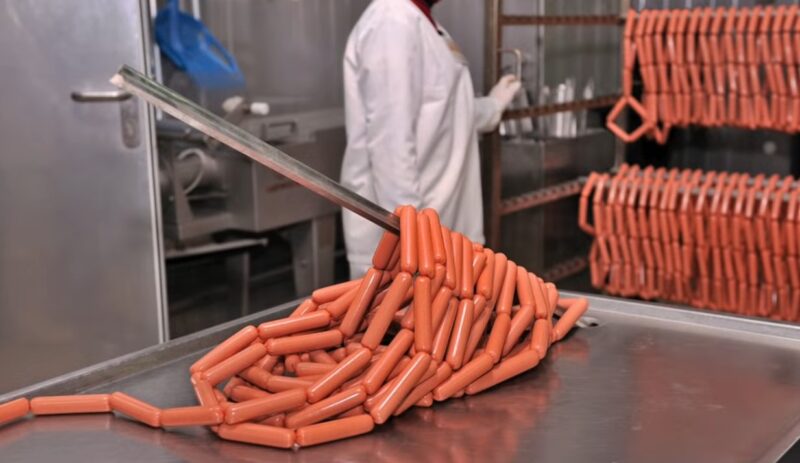Hot dogs are a popular food enjoyed by many, but have you ever wondered if it’s safe to eat them raw? In this article, I will answer the burning question: Can you eat raw hot dogs? Let’s dive in and find out!
Key Takeaways:
- Eating raw hot dogs is not safe due to the risk of listeriosis.
- Hot dogs undergo smoking and cooking processes to ensure safety.
- Reheating hot dogs until they are steaming hot is crucial to kill any potential bacteria.
- Individuals with weak immunity are at a higher risk of food poisoning from raw hot dogs.
- It’s important to practice proper food safety measures when handling and storing hot dogs.
How are Hot Dogs Processed and Cooked?
Hot dogs go through a series of meticulous steps to ensure their preparation and cooking result in a safe and delicious product. The process starts by enclosing the hot dog mixture into casings. These casings can be made of natural materials like collagen or cellulose, or synthetic materials like polymers. Once the hot dogs are encased, they are then moved to a smokehouse for smoking.
In the smokehouse, the hot dogs undergo a smoking process that typically ranges from 109°F to 160°F. This process can last for several hours to a few days, depending on the desired flavor and preservation. The smoking helps preserve the meat and adds a distinct smoky flavor while also aiding in the control of microbial growth.
After smoking, the hot dogs are cooked using various methods to ensure they are safe to eat. This can include submerging the hot dogs in boiling water, dry heating, hot showering, or steam cooking. These cooking methods effectively cook the hot dogs to the desired temperature, ensuring any potential bacteria are killed. It is important to note that even though hot dogs go through these processes, it is still recommended to reheat them before consumption to be extra cautious.
Hot Dog Cooking Methods
| Cooking Method | Description |
|---|---|
| Boiling | The hot dogs are submerged in boiling water until fully cooked. |
| Dry Heating | The hot dogs are cooked using direct heat, such as grilling or broiling, until they reach the desired temperature. |
| Hot Showering | The hot dogs are cooked using steam and hot water showers, ensuring thorough and even cooking. |
| Steam Cooking | The hot dogs are cooked using steam until they are fully heated and cooked through. |
By following these meticulous preparation and cooking processes, hot dogs are made safe for consumption. While the convenience of pre-cooked hot dogs is appealing, it is still essential to reheat them properly to ensure any potential bacteria are eliminated.
The Risks of Eating Raw Hot Dogs

Eating raw hot dogs can pose several risks, including the risk of listeriosis. Listeria monocytogenes bacteria can be present in raw hot dogs and can cause severe food poisoning. This bacterial infection can lead to flu-like symptoms such as fever, muscle aches, and gastrointestinal issues. In more severe cases, it can even lead to meningitis or blood infections. It is important to note that listeriosis can be particularly dangerous for individuals with weak immunity, pregnant women, and the elderly.
Contaminated hot dogs may not show any signs of spoilage, making it important to always reheat them to kill any potential bacteria. Listeria can survive at low temperatures and can contaminate hot dogs during processing and packaging. When hot dogs are consumed raw, the risk of ingesting these harmful bacteria increases significantly. Reheating hot dogs until they are steaming hot is a crucial step in ensuring food safety and reducing the risk of food poisoning.
Proper food handling and storage practices are also essential in preventing hot dog contamination. It is important to store hot dogs in a refrigerator at temperatures below 40°F and to consume them within the recommended time frame. Cross-contamination should be avoided by separating raw hot dogs from other foods, especially those that will be consumed raw or without further cooking. Following these food safety measures can greatly reduce the risk of listeriosis and other foodborne illnesses associated with raw hot dog consumption.
Can Dogs Eat Hot Dogs?

Many dog owners may wonder whether it’s safe to share their favorite treat, hot dogs, with their furry friends. While dogs can technically eat hot dogs, it’s important to exercise caution and moderation due to the potential risks involved.
Feeding hot dogs to dogs can be problematic because they are typically high in fat and sodium, which can lead to gastrointestinal upset and even pancreatitis if consumed in large quantities. Additionally, some hot dog additives, such as artificial coloring and preservatives, are not ideal for dogs’ health.
I recommend opting for leaner alternatives when it comes to treating your dog. Lean chicken or turkey dogs can be a healthier substitute for traditional hot dogs. Cooked lean meats like chicken breast or ground turkey are also suitable options. To add variety to their diet, you can incorporate safe and enjoyable alternatives such as peanut butter, fruits, and vegetables.
Safe Alternatives to Hot Dogs for Dogs
If you’re looking for safe alternatives to hot dogs, here are some options that you can consider:
- Lean chicken or turkey dogs
- Cooked lean meats like chicken breast or ground turkey
- Peanut butter (check for xylitol, which is toxic to dogs)
- Fruits such as apples (without seeds), bananas, or blueberries
- Vegetables like carrots, green beans, or sweet potatoes (cooked and without seasoning)
- Always consult with your veterinarian before introducing new foods to your dog’s diet, especially if they have any existing health conditions or dietary requirements.
Remember to offer treats in moderation and provide a balanced diet that meets your dog’s nutritional needs. By making informed choices and prioritizing their well-being, you can ensure that your furry friend stays healthy and happy.
| Treat Options | Feeding Recommendations |
|---|---|
| Lean chicken or turkey dogs | Offer in moderation as an occasional treat |
| Cooked lean meats like chicken breast or ground turkey | Ensure proper cooking and remove any bones or seasonings before serving |
| Peanut butter (check for xylitol, which is toxic to dogs) | Use as a small amount or hide it in puzzle toys for mental stimulation |
| Fruits such as apples (without seeds), bananas, or blueberries | Slice into small pieces and offer as a refreshing snack |
| Vegetables like carrots, green beans, or sweet potatoes (cooked and without seasoning) | Cook and cut into appropriate sizes for your dog’s breed and size |
Conclusion

In conclusion, it’s important to prioritize raw hot dog safety when considering hot dog consumption. Raw hot dogs pose significant risks, including the potential for food poisoning and listeriosis. The cooking processes of smoking and heating are crucial in ensuring the safety of hot dogs before they are packaged.
To minimize the raw hot dog risks, it is essential to always reheat hot dogs until they are steaming hot. This step is crucial in killing any potential bacteria that may be present. By following proper food safety measures, such as handling and storing hot dogs correctly, we can further reduce the risk of contamination.
In terms of alternatives, it is advisable to opt for healthier options for both humans and dogs. While dogs can technically eat hot dogs, it’s best to limit their consumption due to the high fat and sodium content. Instead, leaner alternatives such as lean chicken or turkey dogs, as well as cooked lean meats like chicken breast or ground turkey, can be offered. For a treat, peanut butter, fruits, and vegetables can also be safe and enjoyable options for dogs.
By being aware of the raw hot dog risks and making informed choices, we can ensure the safety and well-being of ourselves and our furry friends. Prioritizing proper food handling and healthier alternatives will contribute to a healthier and safer hot dog experience for everyone.
FAQ

Can you eat raw hot dogs safely?
No, it is not safe to eat raw hot dogs due to the risk of listeriosis caused by Listeria monocytogenes bacteria. Reheating hot dogs until they are steaming hot is essential to kill any potential bacteria.
How are hot dogs processed and cooked?
Hot dogs are pre-cooked before leaving the factory and undergo smoking and cooking processes. They are enclosed in casings and then smoked at temperatures ranging from 109°F to 160°F. After smoking, hot dogs are cooked using methods such as boiling, dry heating, hot showering, or steam cooking.
What are the risks of eating raw hot dogs?
Eating raw hot dogs can pose the risk of listeriosis, a severe food poisoning caused by Listeria monocytogenes bacteria. Contaminated hot dogs may not show any signs of spoilage, so it is important to always reheat them to kill any potential bacteria.
Can dogs eat hot dogs?
While dogs can technically eat hot dogs, it is not recommended to give them as a regular treat due to their high fat and sodium content. Hot dogs can cause gastrointestinal upset and may lead to pancreatitis in dogs if consumed in large quantities. It is best to offer leaner alternatives such as lean chicken or turkey dogs, or cooked lean meats like chicken breast or ground turkey.
Conclusion
Reheating hot dogs until they are steaming hot is essential to ensure their safety and kill any potential bacteria. It is also important to practice proper food safety measures when handling and storing hot dogs. It is recommended to offer healthier alternatives for both humans and dogs to ensure their well-being.

